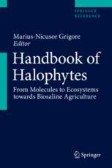Search
Search Results
-
Nutritional, physicochemical and quality profiles of organically sweetened gluten-free breakfast meal from quinoa (Chenopodium quinoa Willd) and tigernuts (Cyperus esculentus L.)
By formulating a breakfast meal from quinoa and tigernuts that is organically sweetened, this study aimed to synergistically utilize the natural...

-
Exploring farmers’ perspectives on agrobiodiversity management: future options for quinoa smallholder organizations in the Peruvian high Andes
The intensification of crop production is widely recognized to negatively affect the agrobiodiversity in smallholder systems. This trend can also be...

-
Vermicompost-based amendment compensated for the reducing effect of water stress on growth and yield of quinoa by improving soil moisture characteristic
Water scarcity has widely affected agricultural production and food security, particularly in arid regions. There is little information available on...

-
Quinoa: Role and Responses Under Abiotic Stress
Quinoa (Chenopodium quinoa Willd.) is a hereditarily distinct Andean crop that has received remarkable interest globally owing to its nutritional and...
-
Quinoa genome assembly employing genomic variation for guided scaffolding
Key messageWe propose to use the natural variation between individuals of a population for genome assembly scaffolding. In today’s genome projects,...

-
Agro-Physiological Response of Quinoa (Chenopodium quinoa Willd.) to the Nitrogen Application Rate and Split Application Method
To investigate the effects of nitrogen application rate and split application method on the growth and yield of quinoa, a split plot experiment was...

-
Re-emergence of Pseudocereals as Superfoods for Food Security and Human Health: Current Progress and Future Prospects
Unlike cereals which are monocotyledons, pseudocereals are dicotyledonous plants and are known as pseudocereals because of the similarity of...
-
The role of tissue succulence in plant salt tolerance: an overview
Soil salinity seriously restricts agricultural production. Halophytes adapt to saline environments through several strategies, including leaf or stem...

-
Agrobiodiversity in Mountain Territories: Family Farming and the Challenges of Social-Environmental Changes
Family farming plays a fundamental role in food production. However, it faces rapid processes of social-environmental change, such as the application...
-
Legume–Rhizobium Symbiosis and Beyond: Producing Synthetic Communities for Increasing Crop Production Under Climate Change Challenges
Rhizobia are a polyphyletic group of soil bacteria, belonging to alpha- and betaproteobacteria classes, able to colonize the rhizosphere and...
-
De novo transcriptome analysis for exploration of genes responding to salinity in a halophyte New Zealand spinach (Tetragonia tetragonioides)
New Zealand spinach ( Tetragonia tetragonioides ) is a coastal plant species with a variety of medicinal uses in Korea. Due to its salt-tolerant...

-
Humic substances and plant abiotic stress adaptation
BackgroundTraditional agriculture is on the front line of climate change, being most impacted by the increase in the intensity and frequency of...

-
Understanding impact of heat, drought, and salinity stresses on growth and physiological attributes of Chenopodium album under field conditions
Utilizing potential of wild crop relatives becomes a necessity under current climate trends scenario. Chenopodium album is a natural inhabitant of...

-
Demystifying the advanced interventions of genetics and modern breeding approaches for nutritional security and sustainability of neglected and underused crop species (NUCS)
The major concerns in underdeveloped nations are malnutrition, bad health, and hunger. The majority of neglected and underused crop species (NUCS)...

-
Broa – A Portuguese Traditional Sourdough Bread, Made of Maize and Rye Flours
This chapter deals with an ancient bread, produced by local small-farmers and households in Portugal. The bread is called Broa, and is made of...
-
Transcriptome analysis of critical genes related to flowering in Mikania micrantha at different altitudes provides insights for a potential control
BackgroundMikania micrantha is a vine with strong invasion ability, and its strong sexual reproduction ability is not only the main factor of harm,...

-
Proteomics—A Powerful Tool for Understanding Saline Stress Response in Germinating Seed
Understanding the mechanism of seed germination in salt-affected habitats is very helpful to develop outstanding salt-resistant varieties with high...
-
Enhancing Seed Germination Under Abiotic Stress: Exploring the Potential of Nano-Fertilization
Nowadays, climate change has a significant and negative impact on global agro-ecosystems. Consequently, the occurrence of abiotic stress is a major...

-
Priming-Mediated Tolerance to Biotic and Abiotic Stresses in Halophytes
Crop loss due to different biotic and abiotic stresses is an ever-increasing problem worldwide. Salinity especially has destructive effects towards...
-
Applications of Some Nanoparticles and Responses of Medicinal and Aromatic Plants Under Stress Conditions
Plants have been the main source of livelihood for human beings since prehistoric times, in the form of wild-collecting or agricultural activities....
